
Assam is a state in northeastern India, south of the eastern Himalayas along the Brahmaputra and Barak River valleys. Assam covers an area of 78,438 km2 (30,285 sq mi). The state is bordered by Bhutan and Arunachal Pradesh to the north; Nagaland and Manipur to the east; Meghalaya, Tripura, Mizoram and Bangladesh to the south; and West Bengal to the west via the Siliguri Corridor, a 22 kilometres (14 mi) wide strip of land that connects the state to the rest of India. Assamese and Boro are the official languages of Assam, while Bengali is an additional official language in the Barak Valley.

Tezpur is a city and urban agglomeration in Sonitpur district, Assam state, India. Tezpur is located on the banks of the river Brahmaputra, 175 kilometres (109 mi) northeast of Guwahati, and is the largest of the north bank cities with a population exceeding 100,000 as per Metropolitan Census 2011.

Guwahati is the biggest city of the Indian state of Assam and also the largest metropolis in northeastern India. Dispur, the capital of Assam, is in the circuit city region located within Guwahati and is the seat of the Government of Assam. A major riverine port city along with hills, and one of the fastest growing cities in India, Guwahati is situated on the south bank of the Brahmaputra. It is called the ''Gateway to North East India''.
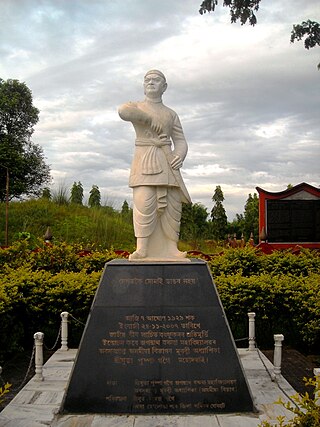
Lachit Barphukan was an Ahom commander, known for his leadership in the Battle of Saraighat that thwarted an invasion by Mughal forces under the command of Ramsingh I.

The Battle of Saraighat was a naval battle fought in 1671 between the Mughal Empire, and the Ahom Kingdom on the Brahmaputra river at Saraighat, now in Guwahati, Assam, India. Although weaker, the Ahom Army defeated the Mughal Army by massive army, clever diplomatic negotiations to buy time, guerrilla tactics, psychological warfare, military intelligence and by exploiting the sole weakness of the Mughal forces—its navy.
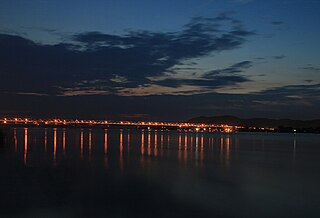
Saraighat is a neighborhood in the Indian city of Guwahati, on the north bank of the river Brahmaputra. Sarai was a small village where the old abandoned N.F. Railway station of Amingaon was located.

The history of Assam is the history of a confluence of people from the east, west, south and the north; the confluence of the Austroasiatic, Tibeto-Burman (Sino-Tibetan), Tai and Indo-Aryan cultures. Although invaded over the centuries, it was never a vassal or a colony to an external power until the third Burmese invasion in 1821, and, subsequently, the British ingress into Assam in 1824 during the First Anglo-Burmese War.
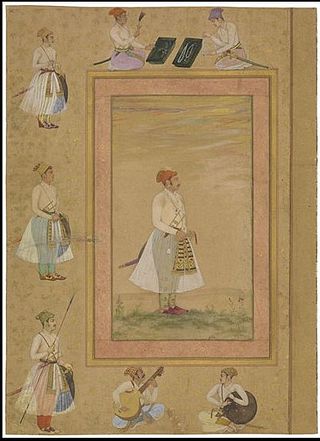
Ram Singh I was the elder son of Jai Singh I and was the ruler of Amber, and head of the Kachwaha Rajput clan. He was also subehdar of Kashmir.

The Ahom kingdom was a late medieval kingdom in the Brahmaputra Valley in Assam. It maintained its sovereignty for nearly 600 years having successfully resisted Mughal expansion in Northeast India. Established by Sukaphaa, a Tai prince from Mong Mao, it began as a mong in the upper reaches of the Brahmaputra based on wet rice agriculture. It expanded suddenly under Suhungmung in the 16th century and became multi-ethnic in character, casting a profound effect on the political and social life of the entire Brahmaputra valley. The kingdom became weaker with the rise of the Moamoria rebellion, and subsequently fell to repeated Burmese invasions of Assam. With the defeat of the Burmese after the First Anglo-Burmese War and the Treaty of Yandabo in 1826, control of the kingdom passed into East India Company hands.

Ahom–Mughal conflicts refer to the period between the first Mughal attack on the Ahom kingdom in Battle of Samdhara in 1616 till the final Battle of Itakhuli in 1682. The intervening period saw the fluctuating fortunes of both powers and the end of the rule of Koch Hajo. It ended with the Ahom influence extended to the Manas river which remained the western boundary of the kingdom till the advent of the British in 1826.
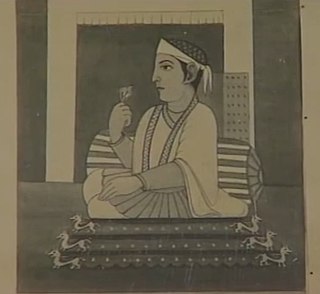
Supaatpha also, Gadadhar Singha established the rule of the Tungkhungia clan of the Ahom kings that ruled the Ahom kingdom till its climactic end. He was the son of Gobar Roja, a descendant of Suhungmung, and who had become the king for a mere 20 days. Previously known as Godapani, Supatphaa was able to stabilize the kingdom after the decade-long turmoil following the Ahom victory in the Battle of Saraighat. This period saw the ruthless power grab of Debera Borbarua and Laluksola Borphukan's abandonment of Guwahati and oppression via Sulikphaa Lora Roja. Supatphaa retook Guwahati from the Mughals for good, and established a strong rule of 'blood and iron'. He came into conflict with the Mayamara Vaishnava sattra which belonged to the folds of Kal "songhoti"and made way for Rudra Singha, his son and succeeding king, to take the kingdom to its zenith.

Supangmung, also known as Chakradhwaj Singha, was an important Ahom king under whom the Ahom kingdom took back Guwahati from the Mughals following the reverses at the hands of Mir Jumla and the Treaty of Ghilajharighat. He is known for his fierce pride as an Ahom monarch.
Atan Burhagohain was an influential 17th-century Burhagohain of the Ahom kingdom. He served as Rajmantri Dangaria, the chief counsellor, for more than seventeen years, from January 1662 to March 1679. During this period Assam witnessed Mughal invasions first under Mir Jumla and later during the Battle of Saraighat against Ram Singh. During the internal disruptions that followed he played a prominent part upholding state rule but was ultimately assassinated by his adversaries. He is best known for his foresight, judgement and patriotism; and for refusing to accept the crown twice when it was offered to him.

The Assamese people are a ethnolinguistic group that has been described at various times as nationalistic or micro-nationalistic. This group is often associated with the Assamese language, the easternmost Indo-Aryan language, and most Assamese people live in the Indian state of Assam, especially in the Brahmaputra valley. The use of the term precedes the name of the language or the people. It has also been used retrospectively to the people of Assam before the term "Assamese" came into use. They are an ethnically diverse group formed after centuries of assimilation of Austroasiatic, Tibeto-Burman, Indo-Aryan and Tai populations, and constitute a tribal-caste continuum—though not all Assamese people are Hindus and ethnic Assamese Muslims numbering around 42 lakh constitute a significant part of this identity The total population of Assamese speakers in Assam is nearly 15.09 million which makes up 48.38% of the population of state according to the Language census of 2011.
Changsari is a town in Kamrup district of Assam, situated on the north bank of the Brahmaputra River. The name Changsari is derived from Tai-Ahom word meaning chang (expert) sa (good) and ri (make), that is, an expert who makes an ill person well. It is a coincidence that the AIIMS is located here. In the Ahom era it was a village of doctors, Changkakati and Baruah.

Purandar Singha was the last king of the Ahom kingdom in Assam. He was installed as king twice. The first time, he was installed by Ruchinath Burhagohain in 1818 CE, after the latter deposed Chandrakanta Singha from the throne. His first reign ended in 1819 CE, during the second Burmese invasion of Assam, when his forces were defeated and the Burmese reinstalled Chandrakanta Singha on the throne. He along with Ruchinath Burhagohain continued their efforts to expel Burmese invaders, by seeking help from British and through armed struggle. After First Anglo-Burmese War, the British East India Company took over Assam from the Burmese invaders. Finding it difficult to administer an unfamiliar region and sensing discontent among the local inhabitants to foreign rule, the British authorities decided to restore Upper Assam to a prince of Ahom Dynasty. Purander Singha was found suitable for this post and therefore, in April 1833 CE, except for Sadiya and Matak rajya, the entire territory of Upper Assam was formally made over to him, on the condition of yearly tribute of 50,000 rupees. Later, in 1838 CE, finding him incompetent and a defaulter in payments of revenue, the British formally annexed his kingdom, putting an end to a 600 years reign of the Ahom dynasty. When Purandar Singha accepted the position of prince over upper Assam, he did not realize the difficulties of his new position.

Jogeswar Singha was installed as the king of Ahom kingdom in 1821 CE, by the Burmese. He was more or less a puppet in the hands of the Burmese, who held the real power of administration. His reign witnessed Burmese atrocities on the people of Assam and the attempts made by Chandrakanta Singha and Purandar Singha to expel Burmese invaders. Historians dispute regarding the date of his deposition from the throne, as some historians claimed that he was deposed by his Burmese masters, after they secured complete victory over the forces of Chandrakanta Singha in 1822 CE, while some sources claimed that he remained as a puppet ruler till termination of Burmese rule in Assam by British East India Company, in 1825 CE, during First Anglo-Burmese War.
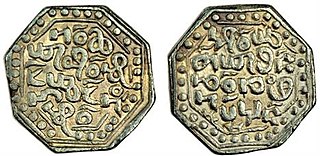
Sunyatphaa also Udayaditya Singha was the king of Ahom Kingdom from 1670 CE to 1672 CE. After his elder brother Swargadeo Chakradhwaj Singha died in the middle of Ahom-Mughal war, Udayaditya Singha succeeded to the throne. His reign witnessed the end of Ahom-Mughal war, which started during the reign of Chakradhwaj Singha, when the Mughal army led by Rajput prince, Ram Singh I of Amber, was decisively defeated by the Ahom forces led by Ahom commander Lachit Borphukan in the Battle of Saraighat. The later part of his reign was characterized by the failure of military expedition against the Dafala tribes and the influence of Paramananda Sannyasi, a saintly figure from Brindaban, over Udayaditya Singha. Udayaditya's over exerted devotion towards Paramananda Sanyasi, aroused dissatisfaction among the nobles, which ultimately caused his deposition and execution. His reign was followed by a series of political anarchy and internal disturbances in the Ahom kingdom which continued till the accession of Gadadhar Singha in 1681 CE.
Ramani Gabharu, was the princess of Kingdom of Assam and the first wife of titular Mughal emperor Muhammad Azam Shah. She was sent to the Mughal harem as part of the Treaty of Ghilajharighat and was renamed Rahmat Banu Begum.

The Battle of Alaboi was a battle fought between the Ahom Kingdom and the Mughal Empire around 5 August 1669. The result was a Mughal victory, but Ram Singh I's next move to open negotiations for peace. The Assamese also were tired of war, and hostilities were suspended for a time. Soon after the battle of Alaboi, Chakradhwaj Singha died in 1669. He was succeeded by his brother Udayaditya Singha. This was part of the seizure of Guwahati that led up to the final Battle of Saraighat which the Ahoms won.















